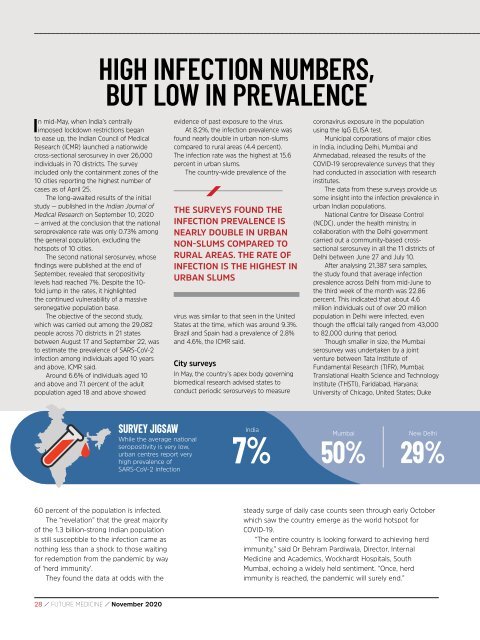FM November2020 Digital P
Create successful ePaper yourself
Turn your PDF publications into a flip-book with our unique Google optimized e-Paper software.
In mid-May, when India’s centrally<br />
imposed lockdown restrictions began<br />
to ease up, the Indian Council of Medical<br />
Research (ICMR) launched a nationwide<br />
cross-sectional serosurvey in over 26,000<br />
individuals in 70 districts. The survey<br />
included only the containment zones of the<br />
10 cities reporting the highest number of<br />
cases as of April 25.<br />
The long-awaited results of the initial<br />
study — published in the Indian Journal of<br />
Medical Research on September 10, 2020<br />
— arrived at the conclusion that the national<br />
seroprevalence rate was only 0.73% among<br />
the general population, excluding the<br />
hotspots of 10 cities.<br />
The second national serosurvey, whose<br />
findings were published at the end of<br />
September, revealed that seropositivity<br />
levels had reached 7%. Despite the 10-<br />
fold jump in the rates, it highlighted<br />
the continued vulnerability of a massive<br />
seronegative population base.<br />
The objective of the second study,<br />
which was carried out among the 29,082<br />
people across 70 districts in 21 states<br />
between August 17 and September 22, was<br />
to estimate the prevalence of SARS-CoV-2<br />
infection among individuals aged 10 years<br />
and above, ICMR said.<br />
Around 6.6% of individuals aged 10<br />
and above and 7.1 percent of the adult<br />
population aged 18 and above showed<br />
HIGH INFECTION NUMBERS,<br />
BUT LOW IN PREVALENCE<br />
evidence of past exposure to the virus.<br />
At 8.2%, the infection prevalence was<br />
found nearly double in urban non-slums<br />
compared to rural areas (4.4 percent).<br />
The infection rate was the highest at 15.6<br />
percent in urban slums.<br />
The country-wide prevalence of the<br />
THE SURVEYS FOUND THE<br />
INFECTION PREVALENCE IS<br />
NEARLY DOUBLE IN URBAN<br />
NON-SLUMS COMPARED TO<br />
RURAL AREAS. THE RATE OF<br />
INFECTION IS THE HIGHEST IN<br />
URBAN SLUMS<br />
virus was similar to that seen in the United<br />
States at the time, which was around 9.3%.<br />
Brazil and Spain had a prevalence of 2.8%<br />
and 4.6%, the ICMR said.<br />
City surveys<br />
In May, the country’s apex body governing<br />
biomedical research advised states to<br />
conduct periodic serosurveys to measure<br />
coronavirus exposure in the population<br />
using the IgG ELISA test.<br />
Municipal corporations of major cities<br />
in India, including Delhi, Mumbai and<br />
Ahmedabad, released the results of the<br />
COVID-19 seroprevalence surveys that they<br />
had conducted in association with research<br />
institutes.<br />
The data from these surveys provide us<br />
some insight into the infection prevalence in<br />
urban Indian populations.<br />
National Centre for Disease Control<br />
(NCDC), under the health ministry, in<br />
collaboration with the Delhi government<br />
carried out a community-based crosssectional<br />
serosurvey in all the 11 districts of<br />
Delhi between June 27 and July 10.<br />
After analysing 21,387 sera samples,<br />
the study found that average infection<br />
prevalence across Delhi from mid-June to<br />
the third week of the month was 22.86<br />
percent. This indicated that about 4.6<br />
million individuals out of over 20 million<br />
population in Delhi were infected, even<br />
though the official tally ranged from 43,000<br />
to 82,000 during that period.<br />
Though smaller in size, the Mumbai<br />
serosurvey was undertaken by a joint<br />
venture between Tata Institute of<br />
Fundamental Research (TIFR), Mumbai;<br />
Translational Health Science and Technology<br />
Institute (THSTI), Faridabad, Haryana;<br />
University of Chicago, United States; Duke<br />
SURVEY JIGSAW<br />
While the average national<br />
seropositivity is very low,<br />
urban centres report very<br />
high prevalence of<br />
SARS-CoV-2 infection<br />
India<br />
7%<br />
Mumbai<br />
50%<br />
New Delhi<br />
29%<br />
60 percent of the population is infected.<br />
The “revelation” that the great majority<br />
of the 1.3 billion-strong Indian population<br />
is still susceptible to the infection came as<br />
nothing less than a shock to those waiting<br />
for redemption from the pandemic by way<br />
of ‘herd immunity’.<br />
They found the data at odds with the<br />
steady surge of daily case counts seen through early October<br />
which saw the country emerge as the world hotspot for<br />
COVID-19.<br />
“The entire country is looking forward to achieving herd<br />
immunity,” said Dr Behram Pardiwala, Director, Internal<br />
Medicine and Academics, Wockhardt Hospitals, South<br />
Mumbai, echoing a widely held sentiment. “Once, herd<br />
immunity is reached, the pandemic will surely end.”<br />
28 / FUTURE MEDICINE / November 2020

















